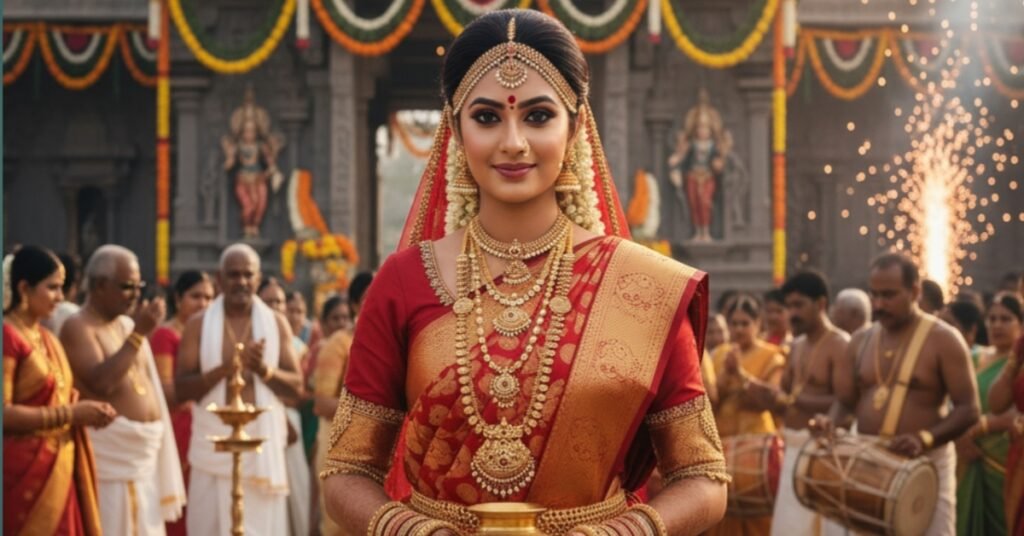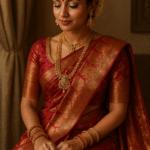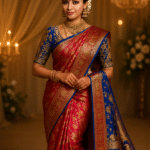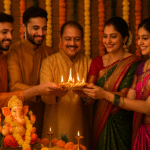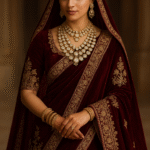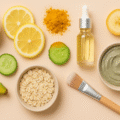✨ Kanjivaram sarees are more than just six yards of silk – they are a piece of living heritage. Woven in the temple town of Kanchipuram, Tamil Nadu, these sarees are known as the “Queen of Silks” for their unmatched elegance, durability, and cultural significance. From ancient temples to modern weddings, Kanjivarams have adorned goddesses, queens, brides, and celebrities alike. With their bold colors, intricate zari borders, and sacred motifs inspired by mythology and nature, every Kanjivaram saree tells a story of tradition, artistry, and timeless grace. Whether passed down as an heirloom or draped on a bride, this iconic silk saree continues to remain a symbol of prestige and pride for Indian women across generations. 🌸👑
Kanjivaram sarees (also called Kanchipuram sarees) are not just garments – they are living heritage. Known as the “Queen of Silks”, these sarees represent luxury, tradition, devotion, and timeless fashion.
From ancient temples of Tamil Nadu to Bollywood red carpets and global fashion runways, Kanjivaram sarees have traveled centuries, keeping their regal charm intact. If there is one saree every Indian woman dreams of owning, it’s undoubtedly a Kanjivaram silk saree.
📖 The Glorious History of Kanjivaram Sarees
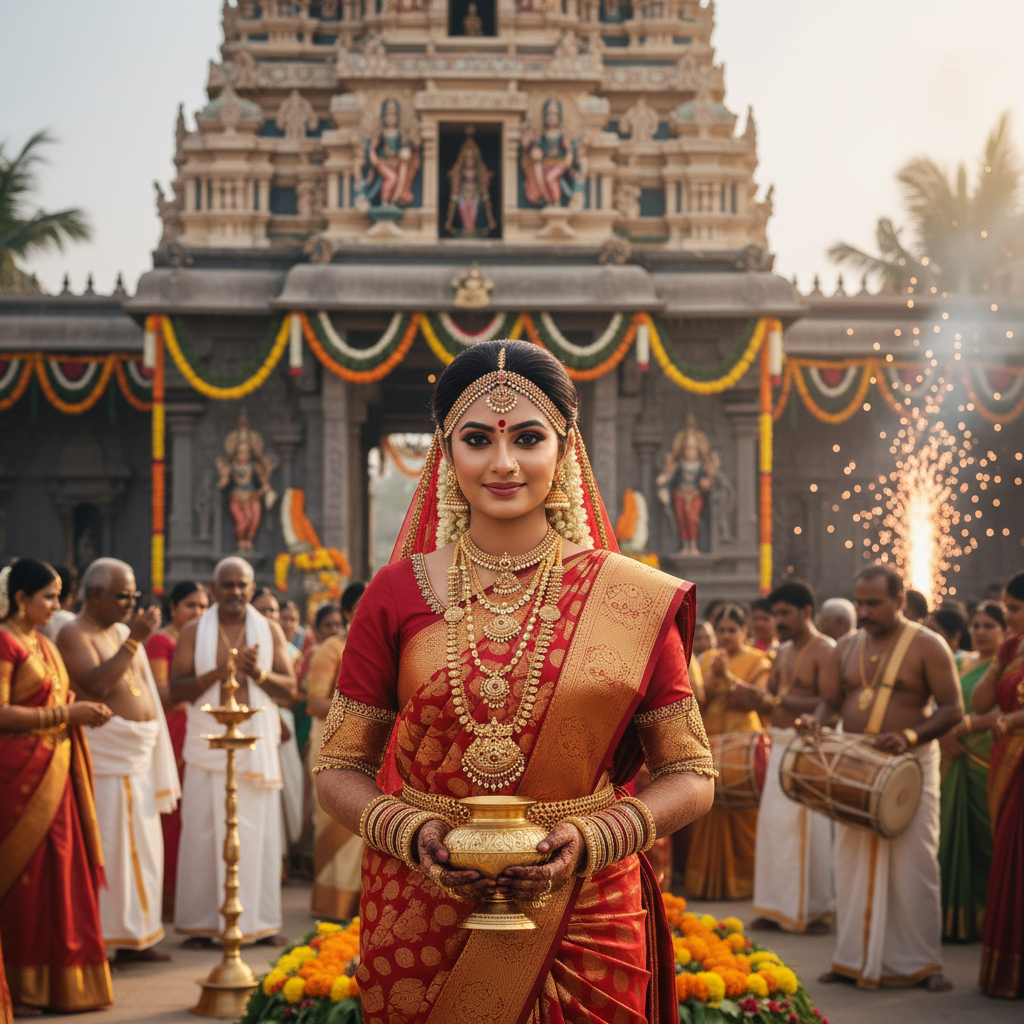
The story of Kanjivaram sarees goes back over 400 years – deeply rooted in mythology, temples, and royal patronage.
🌸 Mythological Origins
According to legend:
- The first weavers of Kanchipuram were the descendants of Sage Markanda, who was considered the weaver of divine fabrics worn by the gods.
- Their weaving was inspired by temple sculptures, mythological stories, and nature.
🛕 Temple Connection
- Kanchipuram is one of the seven sacred cities of India.
- Sarees were woven not just for women but also for dressing temple deities.
- Borders reflected gopuram (temple towers), and motifs symbolized spiritual values.
👑 Royal Patronage
- During the Chola Dynasty (9th–13th century), weaving flourished.
- The Vijayanagara Empire (14th–16th century) gave the saree its prestige by making it a textile for royalty and rituals.
- Queens, aristocrats, and temple dancers adorned themselves in these majestic silks.
🌍 Modern Recognition
Today, Kanjivaram sarees are celebrated across the globe. They are worn by:
- Brides across India 👰
- Celebrities like Rekha, Deepika Padukone, Vidya Balan
- International personalities at cultural festivals
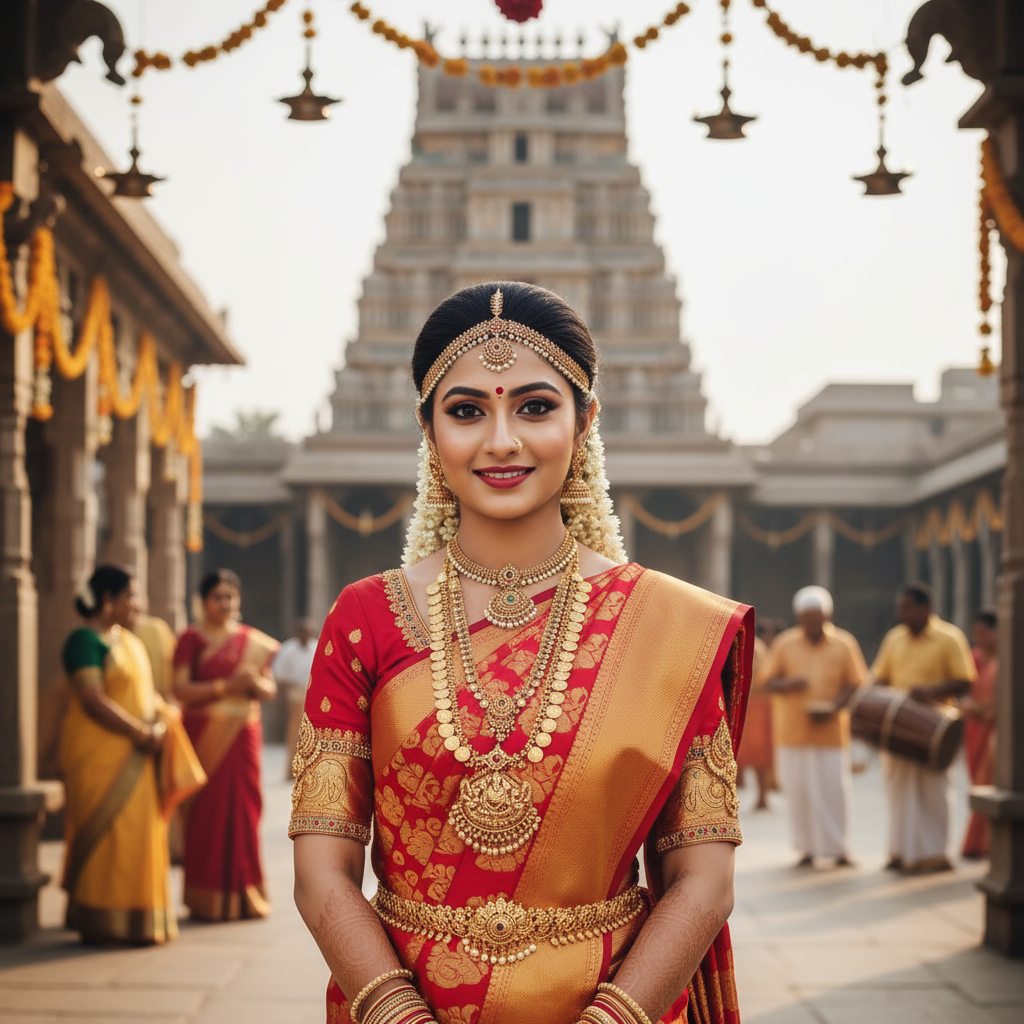
🧵 Step-by-Step Weaving Process of Kanjivaram Sarees
Weaving a Kanjivaram saree is an art of precision and patience. A single saree can take 10–20 days or even months depending on its complexity.
| 🪡 Step | ✨ Process | 🔍 Details |
|---|---|---|
| 1️⃣ Silk Selection | Pure mulberry silk threads | Stronger & shinier than other silks |
| 2️⃣ Zari Preparation | Silver threads coated with gold | Adds shimmer & luxury |
| 3️⃣ Dyeing | Vibrant natural/synthetic colors | Red, maroon, green, blue, gold, pastels |
| 4️⃣ Loom Setup | Warp (vertical) & weft (horizontal) | Traditional handlooms used |
| 5️⃣ Three-Shuttle Technique | Borders, body, and pallu woven separately | Gives Kanjivarams unique contrast |
| 6️⃣ Motif Weaving | Temple, mythological & floral motifs | Woven by hand with zari |
| 7️⃣ Joining Technique (Korvai) | Borders joined to body separately | Known for durability |
| 8️⃣ Finishing | Polishing & folding | Ready for sale |
💡 Fact: A real Kanjivaram saree’s border & body never tear apart, thanks to its special korvai weaving technique.
🎨 Motifs & Their Symbolism
Each Kanjivaram saree tells a story through its motifs. Here’s what they mean:
| 🖼️ Motif | 🌸 Inspiration | 🌟 Symbolism |
|---|---|---|
| 🦚 Peacock | Nature, dance | Beauty, romance, grace |
| 🐘 Elephant | Temples | Strength, royalty |
| 🌸 Lotus | Sacred flower | Purity, divinity |
| 🛕 Temple Borders | South Indian temples | Devotion, spirituality |
| 🐟 Fish | Rivers | Fertility, prosperity |
| 🌟 Chakram (wheel) | Mythology | Eternity, cosmic balance |
| 🦁 Yali (mythical lion) | Temple carvings | Courage, protection |
| 🍂 Mango (paisley) | Nature | Fertility, abundance |
| 🌿 Vines & Creepers | Plants | Growth, prosperity |
🌈 Types of Kanjivaram Sarees
Kanjivarams come in varied designs, motifs, and purposes.
| 🪡 Type | ✨ Features | 🎯 Best For |
|---|---|---|
| Classic Heavy Kanjivaram | Bold colors, heavy zari | Weddings & rituals |
| Lightweight Kanjivaram | Less zari, soft silk | Daily wear, office |
| Checks & Stripes Kanjivaram | Geometric designs | Traditional events |
| Floral & Nature Kanjivaram | Lotus, vines, parrots | Festivals & functions |
| Temple Border Kanjivaram | Inspired by gopurams | Pooja & spiritual wear |
| Contemporary Kanjivaram | Pastels, modern cuts | Parties & receptions |
💰 Price Guide & Buying Tips
Kanjivarams can cost anywhere between ₹5,000 to ₹2,00,000+.
| 💰 Price Range | 🌟 Saree Quality | 🎯 Use |
|---|---|---|
| ₹5,000 – ₹15,000 | Imitation zari, lighter silk | Casual wear |
| ₹15,000 – ₹50,000 | Pure silk, tested zari | Festivals, functions |
| ₹50,000 – ₹2,00,000+ | Pure silk + real gold zari | Bridal & heirloom sarees |
🛍️ Buying Tips:
✅ Always check for Silk Mark Certification.
✅ Original zari feels heavier than fake zari.
✅ Buy from reputed weavers or stores.
✅ Beware of cheap power-loom imitations.
👑 Kanjivaram vs Other Sarees
| Feature | Kanjivaram | Banarasi | Mysore Silk | Paithani |
|---|---|---|---|---|
| Origin | Tamil Nadu | Varanasi | Karnataka | Maharashtra |
| Motifs | Temple, peacock, elephant | Mughal, floral | Minimal, plain | Parrots, lotus |
| Zari | Gold-coated silver | Gold & silver | Subtle | Gold zari |
| Weight | Heavy | Medium-heavy | Light | Medium |
| Use | Weddings, festivals | Weddings, parties | Daily & bridal | Bridal & festive |
👗 Styling Guide – How to Wear Kanjivarams
👰 Bridal Styling
- Saree: Red/maroon heavy zari
- Jewelry: Temple jewelry, kamarbandh, nose ring
- Hairstyle: Bun with jasmine flowers
🌸 Festival Styling
- Saree: Bright green/yellow
- Jewelry: Simple gold bangles & earrings
- Hairstyle: Traditional braid
🎉 Party Styling
- Saree: Pastel or metallic Kanjivaram
- Jewelry: Diamond or pearls
- Blouse: Designer cut
🏢 Office Styling
- Saree: Lightweight beige/grey
- Jewelry: Minimal (pearls or studs)
- Hairstyle: Bun or ponytail
🌸 Maintenance & Storage
- 🧼 Always dry clean
- 📦 Store in muslin/cotton cloth
- 🔄 Refold every 3–6 months
- ☀️ Keep away from direct sunlight
- 🌿 Use neem leaves to avoid insects
🌍 Celebrity Kanjivaram Moments
- 🎬 Rekha – Known as the eternal Kanjivaram queen
- 🎥 Vidya Balan – Promotes handlooms proudly
- 👑 Deepika Padukone – Wore Kanjivaram at her wedding
- 🛕 Aishwarya Rai Bachchan – Seen in temple visits wearing silk sarees
❓ FAQs
- How do I check if a Kanjivaram saree is original?
Look for Silk Mark & check zari heaviness. - Why are Kanjivarams so expensive?
Because of real silk + zari + hand-weaving. - Can I wear Kanjivarams daily?
Yes, lightweight ones are made for office wear. - How long does one saree last?
With care, 30–50 years. - Do brides outside Tamil Nadu wear Kanjivarams?
Yes, they’re popular across India. - Are there pastel Kanjivarams?
Yes, modern weavers make pastel shades. - How to fold a Kanjivaram saree?
Fold along zari lines to avoid breakage. - Can men wear Kanjivaram silk?
Yes, Kanjivaram dhotis exist. - Which is heavier – Banarasi or Kanjivaram?
Kanjivaram is generally heavier. - What is korvai technique?
Special joining of borders with the body.
🌟 Conclusion
The Kanjivaram saree is not just a fabric – it’s a story of devotion, royalty, and artistry. It is:
- A heritage textile 🕊️
- A bride’s dream outfit 👰
- An investment piece 💎
- A symbol of India’s rich culture 🌍
Owning one means owning a piece of timeless tradition – one that connects you to the past, present, and future of Indian fashion.
✨ Whether you’re a bride, a fashion enthusiast, or a collector, a Kanjivaram saree will always remain priceless.
